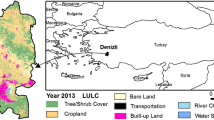Abstract
The landscape structure are investigated for typical and southern tundra subzones of western Siberia based on satellite images from Landsat and WorldView. The microlandscape types for the considered regions are selected and areas of microlandscapes are defined on the basis of satellite information and accounting data of field studies. The areas of the main wetland landscapes in the different types of bogs in northwestern Siberia are defined.
Similar content being viewed by others
References
Bastviken, D., Cole, J., Pace, M., and Tranvik, L., Methane emissions from lakes: Dependence of lake characteristics, two regional assessments and a global estimate, Global Biogeochem. Cycles, 2004, vol. 18, p. GB4009.
Bindoff, N.L., Stott, P.A., Achuta Rao, K.M., Allen, M.R., Gillett, N., Gutzler, D., Hansingo, K., Hegerl, G., Hu, Y., Jain, S., Mokhov, I.I., Overland, J., Perlwitz, J., Sebbari, R., and Zhang, X., Detection and attribution of climate change: from global to regional, in Climate Change 2013: The Physical Science Basis. Contribution of Working Group I to the Fifth Assessment Report of the Intergovernmental Panel on Climate Change, Stocker, T.F., Qin, D., Plattner, G.-K., et al., Eds., Cambridge: Cambridge Univ. Press, 2013, pp. 867–952.
Bryksina, N.A. and Kirpotin, S.N., Landscape–cosmic analysis of change in the area and amount of thermokarst lakes in the permafrost area of West Siberia, Vestn. Tomsk. Gos. Univ.: Biol., 2012, no. 4 (20), pp. 185–194.
Collins, M., Knutti, R., Arblaster, J., Dufresne, J.-L., Fichefet, T., Friedlingstein, P., Gao, X., Gutowski, W.J., Johns, T., Krinner, G., Shongwe, M., Tebaldi, C., Weaver, A.J., and Wehner, M., Long-term climate change: projections, commitments and irreversibility, in Climate Change 2013: The Physical Science Basis. Contribution of Working Group I to the Fifth Assessment Report of the Intergovernmental Panel on Climate Change, Stocker, T.F., Qin, D., Plattner, G.-K., et al., Eds., Cambridge: Cambridge Univ. Press, 2013, pp. 1029–1136.
Elsakov, V.V., The use of satellite imagery for analyzing the values of the chlorophyll index of tundra phytocenoses, Issled. Zemli Kosmosa, 2013, no. 1, pp. 60–70.
Golubyatnikov, L.L. and Denisenko, E.A., Interrelation between the vegetation index and the climatic parameters and structural characteristics of vegetation cover, Izv., Atmos. Ocean. Phys., 2006, vol. 42, no. 4, pp. 484–496.
Karelin, D.V. and Zamolodchikov, D.G., Uglerodnyi obmen v kriogennykh ekosistemakh (carbon Exchange in Cryogenic Ecosystems), Moscow: Nauka, 2008.
Kazantsev, V.S., Methane Emission from Wetland Ecosystems of northern West Siberia, Cand. Sci. (Biol.) Dissertation, Moscow, 2013.
Kornienko, S.G. and Yakubson, K.I., Study of the vegetation transformation in areas of the Tazov Peninsula according to space imagery data, Arktika: Ekol. Ekon., 2011, no. 4, pp. 46–57.
Kravtsova, V.I. and Bystrova, A.G., Change in the sizes of thermokarst lakes in different regions of Russia over the last 30 years, Kriosfera Zemli, 2009, vol. 13, no. 2, pp. 16–26.
Lillesand, T.M., Kiefer, R.W., and Chipman, J.W., Remote Sensing and Image Interpretation, New York: Wiley, 2004.
Liss, O.L., Abramova, L.I., Avetov, N.A., Berezina, N.A., Inisheva, L.I., Kurnishkova, T.V., Sluka, Z.A., Tolpysheva, T.Yu., and Shvedchikova, N.K., Bolotnye sistemy Zapadnoi Sibiri i ikh prirodookhrannoe znachenie (Wetland Systems of West Siberia and Their Environmental Significance), Tula: Grif i Ko, 2001.
McGuire, A.D., Anderson, L.G., Christensen, T.R., Dallimore, S., Guo, L., Hayes, D.J., Heimann, M., Lorenson, T.D., Macdonald, R.W., and Roulet, N., Sensitivity of the carbon cycle in the Arctic to climate change, Ecol. Monogr., 2009, vol. 79, no. 4, pp. 523–555.
Metody otsenki posledstvii izmeneniya klimata dlya fizicheskikh i biologicheskikh sistem (Methods of Assessing the Climate Change Consequences for Physical and Biological Systems), Semenov, S.M., Ed., Moscow: Rosgidromet, 2012.
Naumov, A.V., Dykhanie pochvy: sostavlyayushchie, ekologicheskie funktsii, geograficheskie zakonomernosti (Soil Respiration: Components, Ecological Functions, and Geographical Regularirties), Novosibirsk: SO RAN, 2009.
Olthof, I. and Pouliot, D., Treeline vegetation composition and change in Canada’s Western Subarctic from AVHRR and canopy reflectance modeling, Remote Sens. Environ., 2010, vol. 114, pp. 805–815.
Pavlov, A.V., Monitoring kriolitozony (Monitoring of the Cryolithozone), Novosibirsk: Geo, 2008.
Pokrovskii, O.M., The use of remote sensing data on ocean surface temperature, ice cover, and atmosphere in the Arctic for studying the trends of climate change in Russia, Issled. Zemli Kosmosa, 2007, no. 3, pp. 20–33.
Polyakov, A.V., Timofeev, Yu.M., and Uspenskii, A.B., Temperature–humidity sounding of the atmosphere according to data from the IKFS-2 satellite IR-sounder of high spectral resolution, Issled. Zemli Kosmosa, 2009, no. 5, pp. 3–10.
Raynolds, M., Comiso, J.C., Walker, D.A., and Verbyla, D., Relationship between satellite-derived land surface temperatures, Arctic vegetation types, and NDVI, Remote Sens. Environ., 2008, vol. 112, pp. 1884–1894.
Richards, J.A. and Jia, X., Remote Sensing Digital Image Analysis, Berlin: Springer, 2006.
Riordan, B., Verbyla, D., and McGuire, A.D., Shrinking ponds in subarctic Alaska based on 1950–2002 remotely sensed images, J. Geophys. Res., 2006, vol. 111, G04002. doi 10.1029/2005JG000150
Romanova, E.A., Bybina, R.T., Golitsyna, E.F., Ivanova, G.M., Usova, L.I., and Trushnikova, L.G., Tipologicheskaya karta bolot Zapadno-Sibirskoi ravniny. Masshtab 1: 2500000 (Wetland Typological Map in the West Siberian Plain. Scale 1:2 500 000), Leningrad: GUGK, 1977.
Tutubalina, O.V., Study of the seasonal dynamics of Kola Peninsula vegetation according to Terra MODIS satellite data, Issled. Zemli Kosmosa, 2006, no. 1, pp. 59–67.
Varlamova, E.V. and Solov’ev, V.S., Study of the dynamics of the vegetation index for the Arctic zone of East Siberia according to satellite data, Sovrem. Probl. Distantsionnogo Zondirovaniya Zemli Kosmosa, 2012, vol. 9, no. 1, pp. 65–70.
Author information
Authors and Affiliations
Corresponding author
Additional information
Original Russian Text © L.L. Golubyatnikov, E.A. Zarov, V.S. Kazantsev, I.V. Filippov, G.O. Gavrilov, 2015, published in Issledovanie Zemli iz Kosmosa, 2015, No. 3, pp. 4–14.
Rights and permissions
About this article
Cite this article
Golubyatnikov, L.L., Zarov, E.A., Kazantsev, V.S. et al. Analysis of the landscape structure in the tundra zone for western Siberia based on satellite data. Izv. Atmos. Ocean. Phys. 51, 969–978 (2015). https://doi.org/10.1134/S0001433815090091
Received:
Published:
Issue Date:
DOI: https://doi.org/10.1134/S0001433815090091




